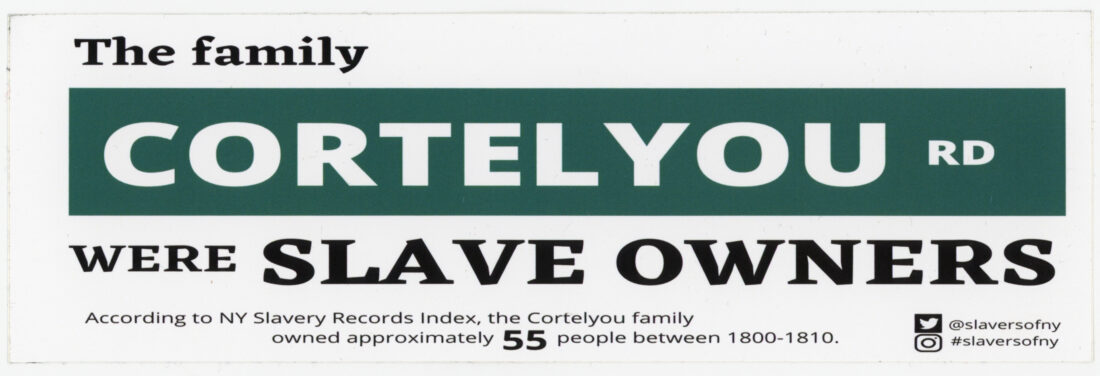Featured artists/activists: Slavers of New York
- Published
- in all, Featured artist, the faith of graffiti, Visual literacy
The Slavers of New York sticker campaign and guerrilla education initiative is the work of three independent activists, Ada Reso, Maria Robles, and Elsa Eli Waithe, who in 2020 began posting stickers that looked like street signs altered to name New York City’s early slaveowners. Using census and manumission records, newspaper listings, and in-depth historical research, they have identified over 200 government officials, businessmen, and wealthy farmers who owned or traded enslaved people from the 1600s through the early 1800s.
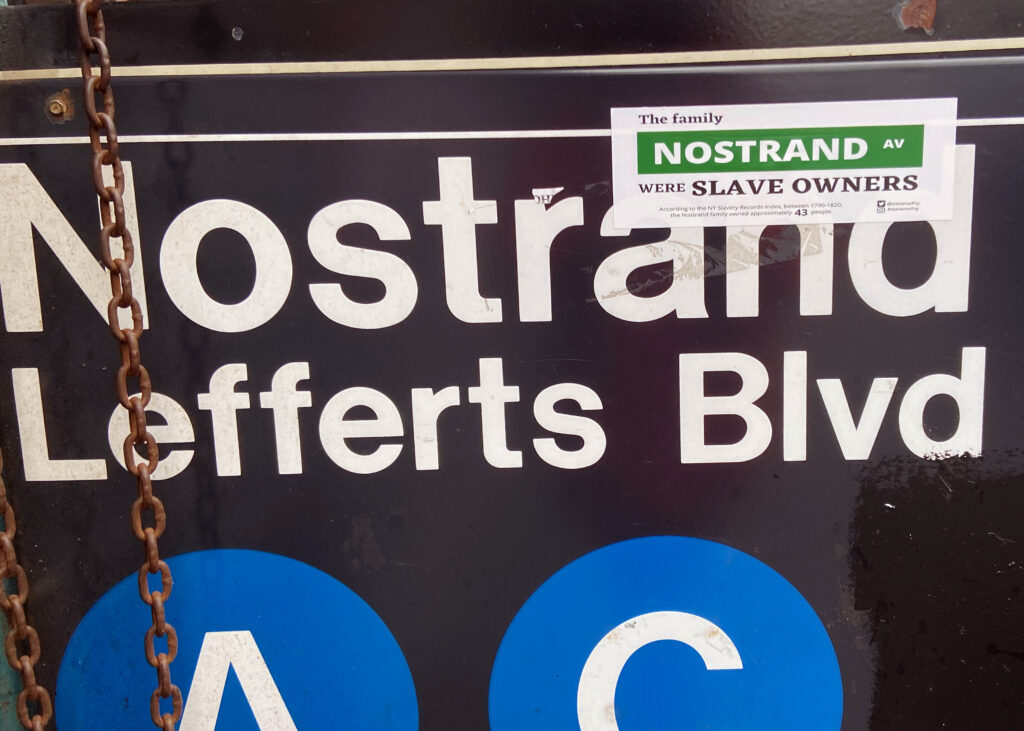
“NOSTRAND AV – The family NOSTRAND were slave owners. According to the NY Slavery Records Index, between 1790-1820, the Nostrand family owned approximately 43 people.”
Photo courtesy of Ada Reso.
For the group’s first sticker, Elsa notes, “Nostrand Ave. is seven miles long in Brooklyn. And … what’s really egregious to me is the fact that Nostrand runs through several predominately Black, historically Black neighborhoods. And John Van Nostrand and the family Nostrand were very instrumental in the slave trade in New York.”[1]
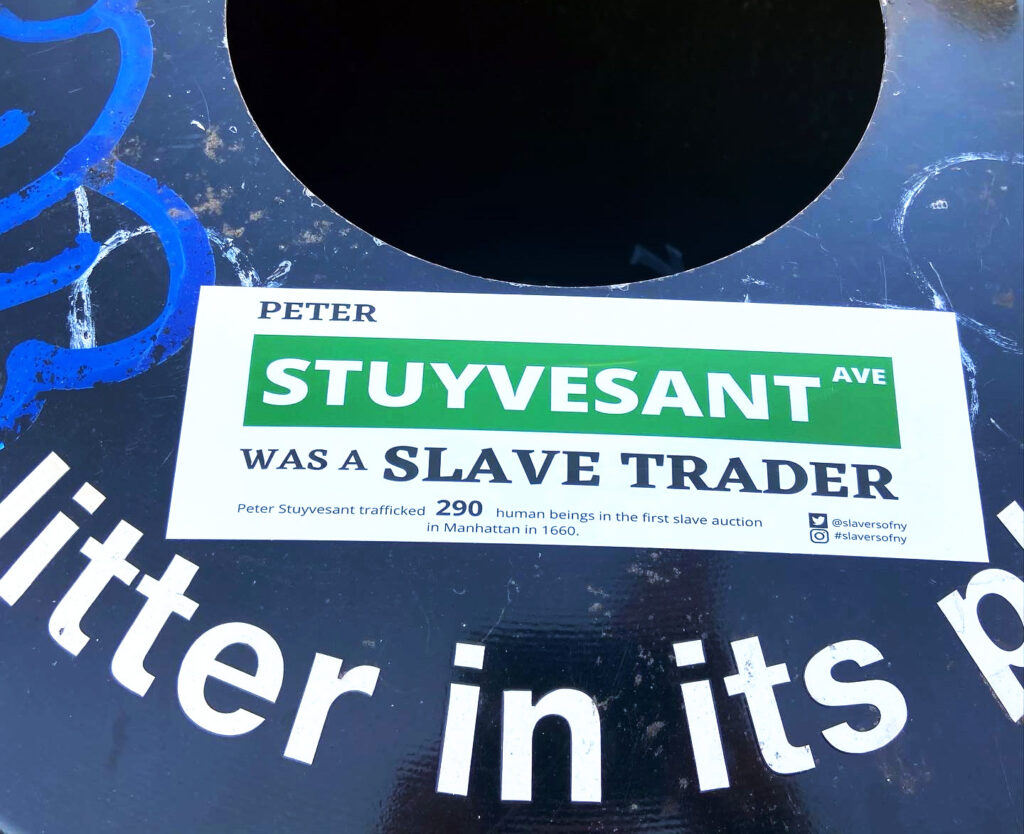
“STUYVESANT AV – Peter STUYVESANT was a slave trader. Peter Stuyvesant trafficked
290 human beings in the first slave auction in Manhattan in 1660.”
Photo courtesy of Ada Reso.
To date, over 2,000 stickers have been plastered around the streets of Brooklyn, with plans to extend the campaign to the other four city boroughs. @slaversofny is also active on Twitter and Instagram, with regular posts “exposing the legacy of racism and slavery in nyc,” and a #StreetNameSaturday campaign that identifies NYC streets named for documented slaveowners. The group’s social media sites also highlight NYC’s history of abolitionists, free Black communities, and Black achievements, as well as those who were involved in the Underground Railroad. The Slavers of New York project is in the process of creating a living history museum through a phone app with an interactive online map, being crowdfunded through GoFundMe.
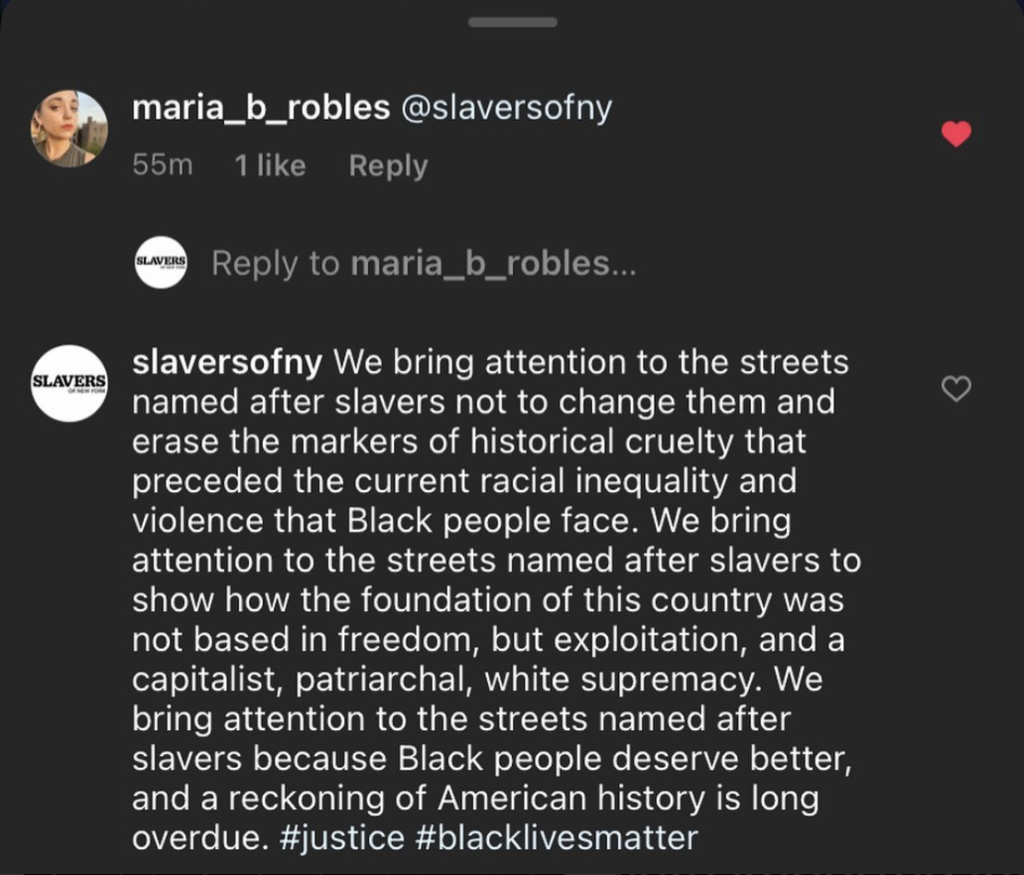
@slaversofny on Twitter: “We bring attention to the streets named after slavers not to change them and erase the markers of historical cruelty that preceded the current racial inequality and violence that Black people face. We bring attention to the streets named after slavers to show how the foundation of this country was not based in freedom, but exploitation, and a capitalist, patriarchal, white supremacy. We bring attention to the streets named after slavers because Black people deserve better, and a reckoning of American history is long overdue. #justice #blacklivesmatter
Describing the Slavers of New York primarily as an educational endeavor, the organizers are not taking a public stance on whether or not to change street names, but as Ada notes, “connecting the past to the present moment is necessary for there to be a real reconciliation for the brutal history of slavery.” Slavery “very much happened here [in NYC],” said Maria. “Who’s being honored across street names and park names, like Stuyvesant and others, and why? We’re not necessarily uncovering anything new. It’s really about taking the data and history that’s already been uncovered and getting it out to as many people as possible.” [2]
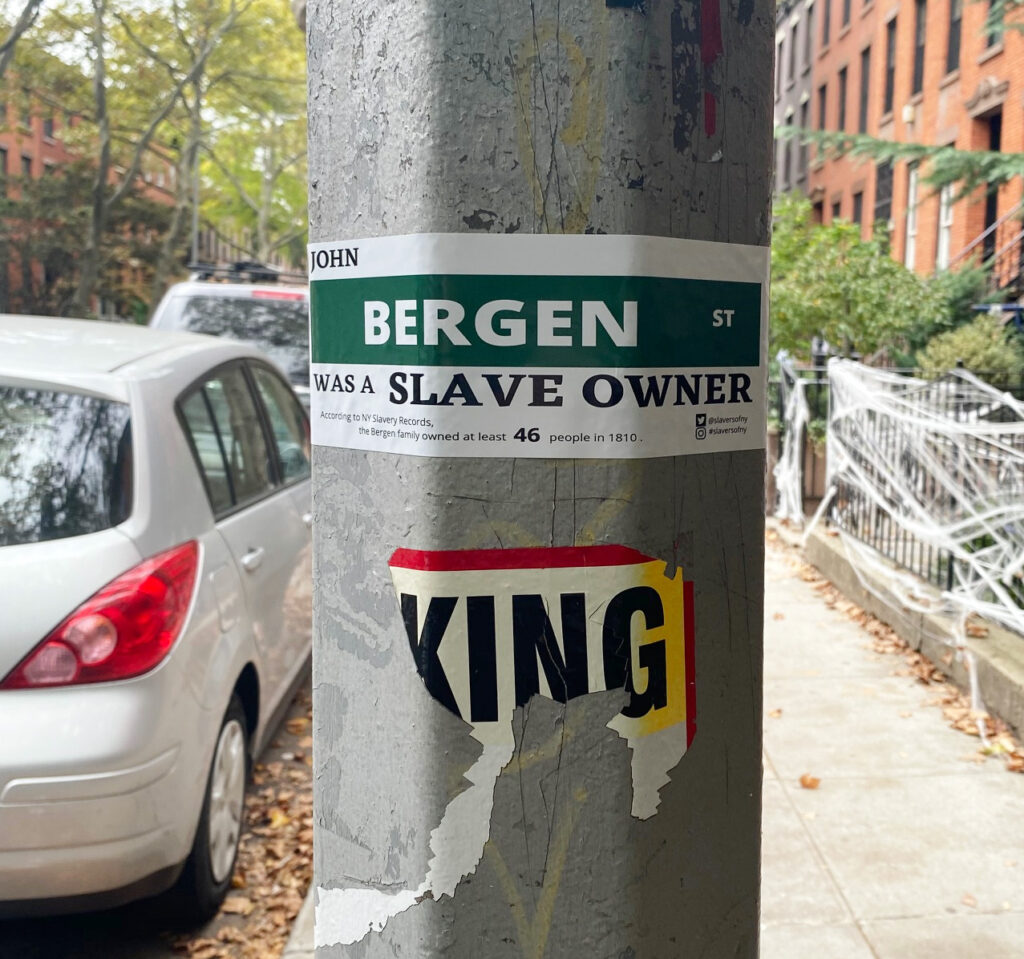
“BERGEN ST – John Bergen was a slave owner. According to NY Slavery Records, the Bergen family owned at least 46 people in 1810.”
Photo courtesy of Maria Robles.
And why stickers? “Stickers are a simple and fast solution…, very discreet, a guerrilla tactic,” said Ada.
INTERVIEW QUESTIONS FOR SLAVERS OF NEW YORK, 10 Dec 2021
- Do you think your stickers move people to take action? If so, how? Could you give any examples? We’ve heard that our stickers prompt people to put more effort into educating themselves about the history of slavery in New York and throughout the United States, and that the stickers have primarily helped people develop a more critical consciousness.
- How do you think through the creation process from format to placement in urban areas? (Some of that I already know from speaking with you and from reading about your project, but I’d love to get any additional thoughts.) We initially wanted to try to modify the street signs. We considered learning metalwork to create our own street signs that would be attached to the original ones. We realized that that wouldn’t work; it would be too labor intensive on our end and easily removed by the city or some other offended party. We realized that stickers would be the best option because it would be easy to place hundreds in half the time it would take to learn and place metalwork. Visually, we wanted the stickers to mimic the street signs. Our reference point was the subway notices for schedule changes, and how New Yorkers know to read them or else end up accidentally taking a train miles away from the intended destination. We hoped to signal that same part of the New York brain with our stickers.
- Have there been any conversations between you as the artists and the people who live in the communities where you place the stickers? Could you describe that a little? Have new dialogues opened up as a result of your project? Honestly, New Yorkers have a “mind-your-own-business” modus operandi so we don’t usually talk to people in the streets about the stickers. When we have, people are usually supportive of our project. We have had a few memorable interactions with residents in Bed-Stuy, Brooklyn while putting up stickers on Stuyvesant Avenue. They were all previously unaware of Peter Stuyvesant’s history with slavery, and mentioned rethinking the pride they felt when talking about their neighborhood name. There was an appreciation for the work we were doing, an enlightenment, and an eagerness to share the information with their peers. The most feedback we get is on social media. We are very active on Twitter, sharing new facts about the history of street names & slavery in NYC on a frequent basis, and our feedback has been overwhelmingly positive, with many people from a variety of backgrounds including historians, educators, activists & more who are thankful for our efforts and for bringing these facts to light in an accessible way.
- Can you envision how people could use your work for teaching students about visual literacy and if so, how? Yes, We think, our project teaches that there is no neutral object. A green rectangle with white font holds a history of colonization, one told by the ‘victors’ as Walter Benjamin said.
[1] Andrea Swindall, “‘Slavers of New York’ Guerilla Stickers Call out NYC’s Celebration of Human Traffickers and Slave Owners,” Inside Edition, May 30, 2021, https://www.insideedition.com/slavers-of-new-york-guerilla-stickers-call-out-nycs-celebration-of-human-traffickers-and-slave.
[2] Reso, Ada, Maria Robles, and Elsa Eli Waithe. Interview by author. Zoom recording. May 18, 2021.
